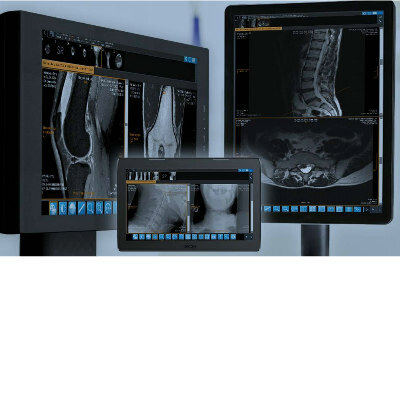3D Human GPS Powered By Light Paves Way for Radiation-Free Minimally-Invasive Surgery
|
By MedImaging International staff writers Posted on 27 Feb 2024 |

In vascular surgery, doctors frequently employ endovascular surgery techniques using tools such as guidewires and catheters, often accessing through arteries like the femoral artery. This method is known as an endovascular procedure. Historically, clinicians had to depend solely on X-ray imaging to navigate these devices through the vascular system. However, X-ray imaging is a double-edged sword: it not only exposes patients and clinicians to potentially harmful radiation but also provides only two-dimensional black and white images. As medical professionals increasingly undertake more complex endovascular procedures, such as repairing aortic aneurysms, the duration of these procedures is increasing, leading to greater radiation exposure for both patients and healthcare providers. Now, a breakthrough innovation in healthcare imaging enables doctors to navigate through blood vessels using light, instead of X-ray.
Philips’ (Amsterdam, Noord-Holland) LumiGuide system which employs Fiber Optic RealShape (FORS) technology marks a major shift in imaging for complex aortic operations, as it does not involve radiation. LumiGuide utilizes light reflected along an optical fiber within a guidewire to create three-dimensional, high-resolution, color images of various devices, such as standard catheters, within the patient’s body. These images are produced in real-time, from any angle, and in multiple views. This technology enables physicians to precisely understand the orientation of their devices and visualize their intended path, all without the need for X-ray imaging. LumiGuide, compatible exclusively with certain Philips interventional systems like Azurion, is the second-generation system incorporating FORS technology.
After its initial limited release to nine aortic centers, over 900 patients have been treated using this technology. One center, conducting a comparative study with traditional methods, reported a 37% reduction in the time taken for complex aortic procedures and a 56% decrease in radiation exposure (DAP) compared to X-ray. Leveraging insights, data, and clinical feedback from its initial use in these centers, LumiGuide has now been enhanced with new features that save time. Unlike the previous requirement for manual registration of devices with the image-guided therapy platform, LumiGuide now employs AI-based technology to quickly and efficiently recognize and register the guidewire. This advancement not only improves accuracy but also further reduces the time required for procedures. The physician's role is simply to confirm the wire’s registration.
LumiGuide is set to enable Philips and its clinical partners to collect more data on its performance at the existing sites, in preparation for a global rollout. With the technology now being introduced to more aortic centers in the USA and Europe, Philips is leading the way toward new radiation-free surgical procedures. Additionally, plans are underway to expand the range of devices compatible with LumiGuide, extending beyond aortic procedures. Philips is moving towards a future of entirely radiation-free surgeries, which signifies a leap towards easier, faster, and safer medical care for both patients and healthcare professionals.
"If we can see more, we can proceed more quickly and more confidently," said Dr. Atul Gupta, Chief Medical Officer for Image Guided Therapy and Precision Diagnosis at Philips and practicing interventional radiologist. “In effect, LumiGuide is a 3D human GPS powered by light.”
Latest Radiography News
- Novel Breast Imaging System Proves As Effective As Mammography
- AI Assistance Improves Breast-Cancer Screening by Reducing False Positives
- AI Could Boost Clinical Adoption of Chest DDR
- 3D Mammography Almost Halves Breast Cancer Incidence between Two Screening Tests
- AI Model Predicts 5-Year Breast Cancer Risk from Mammograms
- Deep Learning Framework Detects Fractures in X-Ray Images With 99% Accuracy
- Direct AI-Based Medical X-Ray Imaging System a Paradigm-Shift from Conventional DR and CT
- Chest X-Ray AI Solution Automatically Identifies, Categorizes and Highlights Suspicious Areas
- AI Diagnoses Wrist Fractures As Well As Radiologists
- Annual Mammography Beginning At 40 Cuts Breast Cancer Mortality By 42%
- Novel AI Technology to Revolutionize Cancer Detection in Dense Breasts
- AI Solution Provides Radiologists with 'Second Pair' Of Eyes to Detect Breast Cancers
- AI Helps General Radiologists Achieve Specialist-Level Performance in Interpreting Mammograms
- Novel Imaging Technique Could Transform Breast Cancer Detection
- Computer Program Combines AI and Heat-Imaging Technology for Early Breast Cancer Detection
- AI Outperforms Human Readers in Detecting Lung Nodules on X-Rays
Channels
MRI
view channel
PET/MRI Improves Diagnostic Accuracy for Prostate Cancer Patients
The Prostate Imaging Reporting and Data System (PI-RADS) is a five-point scale to assess potential prostate cancer in MR images. PI-RADS category 3 which offers an unclear suggestion of clinically significant... Read more
Next Generation MR-Guided Focused Ultrasound Ushers In Future of Incisionless Neurosurgery
Essential tremor, often called familial, idiopathic, or benign tremor, leads to uncontrollable shaking that significantly affects a person’s life. When traditional medications do not alleviate symptoms,... Read more
Two-Part MRI Scan Detects Prostate Cancer More Quickly without Compromising Diagnostic Quality
Prostate cancer ranks as the most prevalent cancer among men. Over the last decade, the introduction of MRI scans has significantly transformed the diagnosis process, marking the most substantial advancement... Read moreUltrasound
view channel
Deep Learning Advances Super-Resolution Ultrasound Imaging
Ultrasound localization microscopy (ULM) is an advanced imaging technique that offers high-resolution visualization of microvascular structures. It employs microbubbles, FDA-approved contrast agents, injected... Read more
Novel Ultrasound-Launched Targeted Nanoparticle Eliminates Biofilm and Bacterial Infection
Biofilms, formed by bacteria aggregating into dense communities for protection against harsh environmental conditions, are a significant contributor to various infectious diseases. Biofilms frequently... Read moreNuclear Medicine
view channel
New SPECT/CT Technique Could Change Imaging Practices and Increase Patient Access
The development of lead-212 (212Pb)-PSMA–based targeted alpha therapy (TAT) is garnering significant interest in treating patients with metastatic castration-resistant prostate cancer. The imaging of 212Pb,... Read moreNew Radiotheranostic System Detects and Treats Ovarian Cancer Noninvasively
Ovarian cancer is the most lethal gynecological cancer, with less than a 30% five-year survival rate for those diagnosed in late stages. Despite surgery and platinum-based chemotherapy being the standard... Read more
AI System Automatically and Reliably Detects Cardiac Amyloidosis Using Scintigraphy Imaging
Cardiac amyloidosis, a condition characterized by the buildup of abnormal protein deposits (amyloids) in the heart muscle, severely affects heart function and can lead to heart failure or death without... Read moreGeneral/Advanced Imaging
view channel
New AI Method Captures Uncertainty in Medical Images
In the field of biomedicine, segmentation is the process of annotating pixels from an important structure in medical images, such as organs or cells. Artificial Intelligence (AI) models are utilized to... Read more.jpg)
CT Coronary Angiography Reduces Need for Invasive Tests to Diagnose Coronary Artery Disease
Coronary artery disease (CAD), one of the leading causes of death worldwide, involves the narrowing of coronary arteries due to atherosclerosis, resulting in insufficient blood flow to the heart muscle.... Read more
Novel Blood Test Could Reduce Need for PET Imaging of Patients with Alzheimer’s
Alzheimer's disease (AD), a condition marked by cognitive decline and the presence of beta-amyloid (Aβ) plaques and neurofibrillary tangles in the brain, poses diagnostic challenges. Amyloid positron emission... Read more.jpg)
CT-Based Deep Learning Algorithm Accurately Differentiates Benign From Malignant Vertebral Fractures
The rise in the aging population is expected to result in a corresponding increase in the prevalence of vertebral fractures which can cause back pain or neurologic compromise, leading to impaired function... Read moreImaging IT
view channel
New Google Cloud Medical Imaging Suite Makes Imaging Healthcare Data More Accessible
Medical imaging is a critical tool used to diagnose patients, and there are billions of medical images scanned globally each year. Imaging data accounts for about 90% of all healthcare data1 and, until... Read more
Global AI in Medical Diagnostics Market to Be Driven by Demand for Image Recognition in Radiology
The global artificial intelligence (AI) in medical diagnostics market is expanding with early disease detection being one of its key applications and image recognition becoming a compelling consumer proposition... Read moreIndustry News
view channel
Bayer and Google Partner on New AI Product for Radiologists
Medical imaging data comprises around 90% of all healthcare data, and it is a highly complex and rich clinical data modality and serves as a vital tool for diagnosing patients. Each year, billions of medical... Read more



















